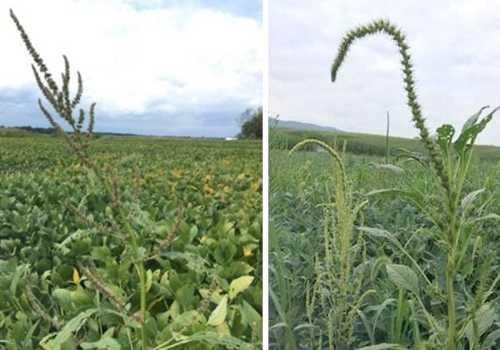By John Wallace and Heidi Reed
Palmer amaranth and waterhemp, which are resistant to multiple herbicide modes-of-action, continue to be introduced and slowly spread in Pennsylvania. Scouting for new introductions or weed escapes in soybean and corn prior to harvest is necessary to slow the spread of these species. Key identification characteristics that distinguish Palmer amaranth and waterhemp from other pigweeds include the presence of male and female plants, hairless stems, and unique floral structures.
We strongly encourage rogueing, hand removal, or mowing of small Palmer amaranth or waterhemp infestations. Localized populations of these species found on headlands or field margins likely represent a new introduction. Additional costs associated with removal will prevent even more significant labor, herbicide input costs, and crop yield loss in subsequent years if populations continue to expand. Populations that are distributed throughout fields are likely a sign that these species have gone undetected for more than one year. Palmer amaranth and waterhemp commonly produce between 20,000 to 80,000 seeds per plant in soybean and studies have shown that mature seed is almost completely retained (>98%) on the plant at harvest. Consequently, combine harvest represents a significant dispersal event, where localized populations can become distributed within and across fields in a single year. Consider these best management practices during combine harvest to prevent and limit further weed seed spread (from GROWIWM):
- Scout fields before harvest, and identify which fields have herbicide-resistant weed infestations
- Harvest herbicide-resistant weed-infested fields, or portions of fields last
- If the combine or tillage equipment entering a field has recently been in a field with herbicide-resistant weeds, clean the equipment, or use different equipment if it is available
- Carefully and completely clean combines when purchased used
- Start cleaning the combine from the top, and moving from the header backward
- Use an air compressor to remove as many weed seeds from the combine as possible, including the rock trap, grain auger, and tailings processor
- Deep clean the combine following the Straw Bale Methodology when moving from fields infested with herbicide resistant weeds, and at the end of the year

(L) Female waterhemp breaking through soybean canopy; (R) Female (right foreground) and male (left foreground) Palmer amaranth plants breaking through soybean canopy.
Waterhemp and Palmer amaranth plants that pass through the cutter-bar at harvest can still potentially survive and set seed, particularly when fall weather conditions are favorable for regrowth. Consider post-harvest herbicide applications of 2,4-D, dicamba, or paraquat to control regrowth of these species in order to prevent additional seed production. Continue to scout fields and take action if necessary. Preventing weed spread is an important tool in the integrated weed management (IWM) toolbox, and cleaning equipment and post-harvest management is worth the time and effort today to prevent a serious management challenge in the future.
Source : psu.edu